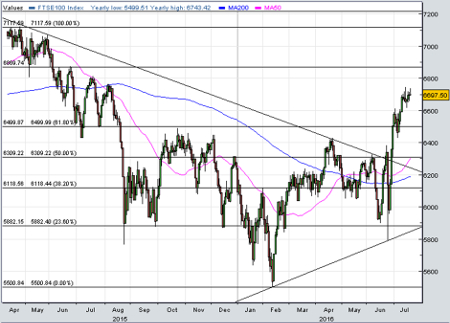Why FTSE 100 pause is misleading
20th July 2016 14:37
by Lee Wild from interactive investor
Share on
Wall Street has just hit a record high and the FTSE 100 made almost 1,000 points in an amazing rally from its post-Brexit low. It's understandable, then, that investors hooked on oversized market moves grow restless when there's an inevitable pause. But it does beg the question whether we should be reading more into this hiatus.
Since the close of play on 11 July, the FTSE 100 is up 20 points. That's chicken feed and barely worth mentioning in an age where we've grown accustomed to wild swings and extreme volatility. The index would likely be flat if you strip out the 40% surge in since the £24 billion takeover bid from .
But, as in the problem with the FTSE 100, all is not as it seems. Two-thirds of the index is up since 11 July, and over a quarter by 3% or more. Behind ARM sit , , British Airways-owner and insurers and , all up around 7%.
Bombed-out bank is now less of a car crash after a 6% rally in the past nine days narrowed its post-Brexit loss to 24%. A contrarian trade into cheap property stocks has proved popular, too, with , and up almost 6%.
In fact, excluding ARM, eight of the top 10 risers since 11 July were among the biggest losers in the post-referendum rout, implying a wave of bargain hunting is in full-swing.
Conversely, the biggest losers over the same period are among those who'd done best in the aftermath of Brexit. , up 35% since 23 June, has lost over 8% since the start of last week. Fellow miners and have done equally badly, and previously high-flying safe-havens , and have succumbed to heavy profit-taking.

Understandably, there's some reluctance to load up on stock ahead of tomorrow's meeting of the European Central Bank. Still, property plays, insurers and financials remain in demand Wednesday.
shares hit a record high after UBS decided the insurer's international and home businesses could be a major growth driver over the next five years. Previously overlooked by the broker, it now thinks they could add as much as 33% to net income in 2020.
Predicting "near-term earnings surprises," UBS upgrades the shares to 'buy' and ramps up its price target by 27% to 2,339p. It's also worth noting the 6.5% prospective dividend yield.
Heavy losses among miners
True, buying in most sectors is modest, but it's heavy losses among the miners that's hobbled the blue-chip index.
Anglo American sunk by 10% Wednesday after warning that bad weather at its Los Bronces copper mine in Chile will cost it as much as 60,000 tonnes of production in 2016, and another 50,000 next year. Investors are racing to bank fat profits after the shares rocketed as much as fourfold since January.
, , and are down in sympathy.
Of course, there are plenty of stocks that are beginning to look expensive, but, as we've mentioned before, from a charting perspective there's clear air between current levels and 6,900.
Technical analyst and Interactive Investor contributor Alistair Strang certainly thinks so. You can find out the "forceful arguments" he's discovered for a further rally on the current movement cycle here.
This article is for information and discussion purposes only and does not form a recommendation to invest or otherwise. The value of an investment may fall. The investments referred to in this article may not be suitable for all investors, and if in doubt, an investor should seek advice from a qualified investment adviser.